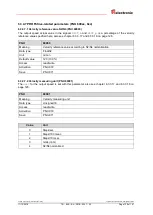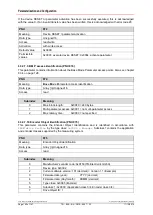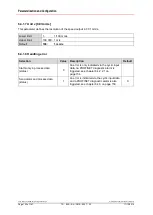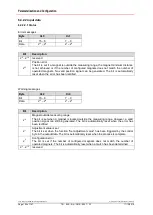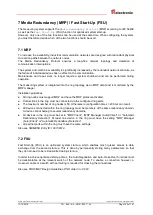
Printed in the Federal Republic of Germany
TR-Electronic GmbH 2018, All Rights Reserved
11/12/2019
TR - ELA - BA - DGB - 0027 - 03
Page 147 of 167
6.3.6.2 PROFINET diagnosis alarm
PROFINET supports an integrated diagnostic concept, which enables efficient error detection and
elimination. When an error occurs, the defective IO device transmits a diagnostic alarm to the IO
controller. This alarm calls up a corresponding program routine in the controller program, in order to
react to the error.
Alternatively, the diagnostic information can also be manually acyclically read out directly from the IO
device via record index 0xE00C and displayed on an IO supervisor.
Alarms belong to the acyclic frames which are transmitted via the cyclic RT channel. They are also
identified by
Ether type = 0x8892
.
Errors and warnings are transmitted by the measuring system to the IO controller in the form of a so-
called Alarm Notification Request (alarm message). For identification purposes the alarm message
contains the alarm-ID (diagnosis, process), the addressing information (slot, subslot, module ID) and
the channel-related diagnosis (channel no., channel type and error type) or, instead of this, a
manufacturer-specific diagnosis with transmission of an error code.
A slot with
API = 0x3D00
(encoder profile ID) identifies the measuring system object.
The exact structure of the
Alarm Notification Request
can be found e.g. in the PROFINET
specification
Application Layer protocol for decentralized periphery and distributed automation
,
order
no.: 2.722
.
An error is transmitted via the alarm channel with
Frame-ID
=
0xFC01
"PROFINET IO Alarm high"
and warnings with
Frame-ID
=
0xFE01
"PROFINET IO Alarm low".
Depending on the setting, channel-specific, communication-specific and manufacturer-specific alarms
are supported by the measuring system.
In order to be able to use channel-specific alarms, the following setting must be made:
● Parameter
Compatibility Mode V3.1 = enable
● Parameter
Alarm channel control = enable
If the setting
Alarm channel control = disable is made in compatibility mode,
only communication-specific alarms are sent.
In order to be able to use manufacturer-specific alarms, the following setting must be made:
● Parameter
Compatibility Mode V3.1 = disable
In the
Alarm Notification Request
, the type of alarm is displayed via the attribute
UserStructureIdentifier
.
For a channel-specific diagnosis the UserStructureIdentifier
has a value of
0x8000. This is
followed by the attributes
ChannelNumber
,
ChannelProperties
and
ChannelErrorType
. In the
ChannelErrorType
attribute, the error type is specified and temporarily stored in the measuring
system.
The measuring system supports the two error types
●
Position error, 0x9100
and
●
Memory error,
0x9116
These are synonymous with the errors defined in
PNU 65001
, Subindex 2, see chapter "Error (PNU
65001.02)" on page 133. The error is acknowledged in the same way.







